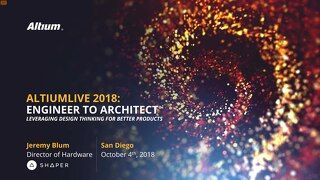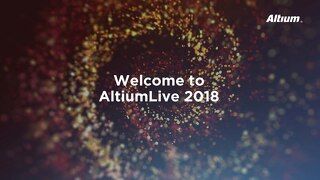AltiumLive 2019 is on the Books
The Robot Building Competition. First picture: Team 15 with Judy Warner and Industry Expert, Sven Ingelfinger. Second picture: Winning team of The Battle of The Robots in AltiumLive 2019 Europe. Source: Linkedin
Here I find myself sitting in the departure terminal of the Frankfurt Airport, heading back home to San Diego after completing another successful AltiumLive event. I have had the great pleasure of participating in this event since they first began in San Diego in 2017, and I must say both this year's San Diego and Frankfurt events were the best by far. No one was disappointed.
We had the best keynote speakers, which in San Diego included in Robert Feranec, Bob Martin, Eric Bogatin, Joe Grand, Frankfurt Rick Hartley, Happy Holden, Jeremy Blum, and Carl Schattke. It was an absolutely power-packed event. If that was not enough, there was also the Annual Robot Competitions. There has been a discussion for many years now about replacing this event with something else, but personally, there is nothing better than alcohol, nerds, and robots. This year the robots were bigger and more powerful, and it showed when parts began to fly.
I decided that in this blog, it would be good to revamp some of the great questions that were asked during the numerous discussions and breakaways and the answers.
Q & A
Concord Pro
Q. What are the differences between Nexus and Concord Pro?
A. Having just been released, Concord Pro is the new “kid on the block,”and naturally there is still some confusion of the exact differences between Nexus and Concord Pro. First, Nexus has the configurable manageable workflows. Nexus can fully control the project design process with signoffs. These are excellent features, though depending on your company size, it might be using the proverbial Rocket launcher to kill a fly. Another difference is the integration of the Library to either the Arena, Agile, or Windchill product lifecycle mangement systems (PLM). Nexus can handle both Components and Project Data, but Concord Pro only handles components.
Q. Are you able to migrate libraries into Concord Pro?
A. Yes, you can migrate any library into Concord Pro through a migration tool. In the upcoming release of Altium 20, an improvement has been made with the migrator to make this even more accessible—and faster.
Q. Where do you see Component Libraries going in the future?
A. That was an excellent question and one that got me thinking about how, with continued advancements in ECAD software and the types of partnerships that, for example, Altium has developed with such companies as Ciiva and Octopart, the sky is the limit and there seems to be no end to the possibilities.
But I do see that the day may come when personal or local libraries will no longer be needed. When the components would be so standardized and all needed information and models included (which happening more and more) that you could directly use a component in a design. Of course, this would not completely preclude the need for local libraries. There will still be company proprietary components.
ACTIVEBOM®
Once again, this year, I had the great opportunity to team up with Vince Mazur from Altium to present a professional breakout on Overcoming Electronic Part Challenges. Looking at several challenges facing PCB Designers and how the Altium features Manufacturer Panel, Component Panel, and ACTIVEBOM, can help us. Some outstanding questions came from that session.
Q. Why is there a difference between information from ACTIVEBOM and the suppliers' information?
A. That was a common question. Some have noticed that a component may be flagged by ACTIVEBOM as Not Recommended for New Designs (NRFND) or could even be Obsolete. But when you go to a specific supplier, such as Digikey, Mouser, Farnell, etc., there is no indication that the component is deprecating. So, why the discrepancy? A couple reasons. First, the information in ACTIVEBOM is cached and updated. If you look at the Supplier panel, you see the last time component was refreshed. Furthermore, keep in mind that Altium does not look only at a single vendor to determine if a component is reaching End-of-Life (EOL); this is the result of looking at multiple sources of information, including (I learned at AltiumLive), proprietary projected future component supplies.
I must admit, I’ve also seen this issue. But when we let the component get approved and then placed into a design, ignoring the fact that ACTIVEBOM was warning us not to; every single time, even if it was 6-months later, the component actually did go into End-of-Life. At this point, I am a firm believer that the developers at Altium are clairvoyant.
Q. What is an excellent way to handle Mechanical parts in the BOM?
A. There are several ways to do that. One way I would probably not do it is to add those items strictly to the ACTIVEBOM. The rule is to not change the Child without changing the parent. The BOM is a “child” document, with the parent being the schematic. Any changes start in the schematic. The problem you would encounter if you only updated the BOM (Child) and not the schematic (Parent) is they’d become out of sync, and if you update the BOM from the schematic, it removes all the manual updates you did. So, I think it’s clear that this is not a good practice.
But to answer the question, an excellent way is to either place those mechanical components in the schematic or in the mechanical part list. These are mechanical components that have a symbol (such as a picture of the part) and a footprint that has only the 3D model. That gives some great flexibility in your design.
Q. Can ACTIVEBOM be used for MultiBoard Designs?
A. With the upcoming release of Altium 20, the answer to that question is “Yes.” ACTIVEBOM supports system-level BOM documents. In familiar Altium fashion, they’ve continue to raise the bar. I have started to beta test these features, and let’s just say you’re going to like what you see.
Conclusion
I want to give a big shout out to everyone from Altium who participated in the AltiumLive events in San Diego and Frankfurt. You are some of the greatest folks that I have ever worked with. Some way somehow, you make it all happen. An event on the scale of AltiumLive is an unsung sort of job with much of the activity being behind the scene. But it is done without fanfare.
All I have for everyone is a BIG THANK YOU.
Special thanks to Lawrence Romine and Judy Warner for the indefatigable effort that you give to support us lowly PCB designers. I cannot put into words what these events mean to us. I have worked with lots of people in my career, but no one comes to the level of professionalism than these folks in the photo do. I consider it the highlight of my career be around them.
The team behind the organization of AltiumLive 2019.
In this blog, we have been looking at questions, however, I have a question for everyone who did not attend one of the events.
”WHY WERE YOU NOT THERE?”
Sure, you have seen the benefit of attending. You have seen how designers leave with a new passion for PCB Design. You have heard about the eye-opening keynotes. Well, next year there will be another AltiumLive event. Make the decision NOT TO MISS IT right now.
Check out the top posts on LinkedIn
Check out these tape-ups! Sharing a bit of PCB history now at AltiumLive 2019 - thank you Carl Schattke, CID+ for sharing will all of us! Source: LinkedIn
Great to meet up with "the legends" at AltiumLive this evening. All is set for a fantastic couple of days. Source: LinkedIn
At AltiumLive 2019 in San Diego with Special Guest Brockett Parsons, keyboard player for Lady Gaga. We're in awe over his PianoArc. Source: LinkedIn
Learn how to utilize BOM management to keep your PCB design right. Have more questions? Call an expert at Altium.


